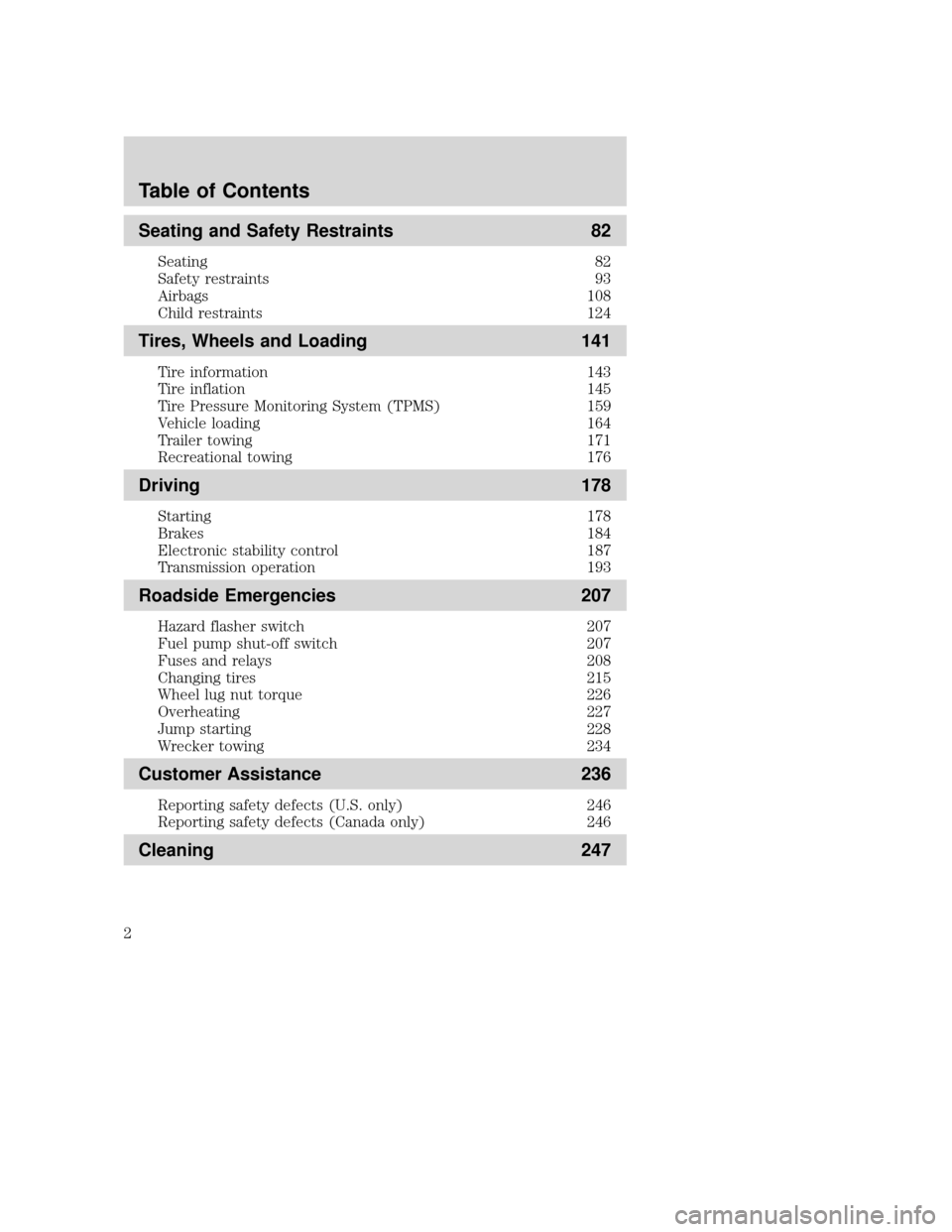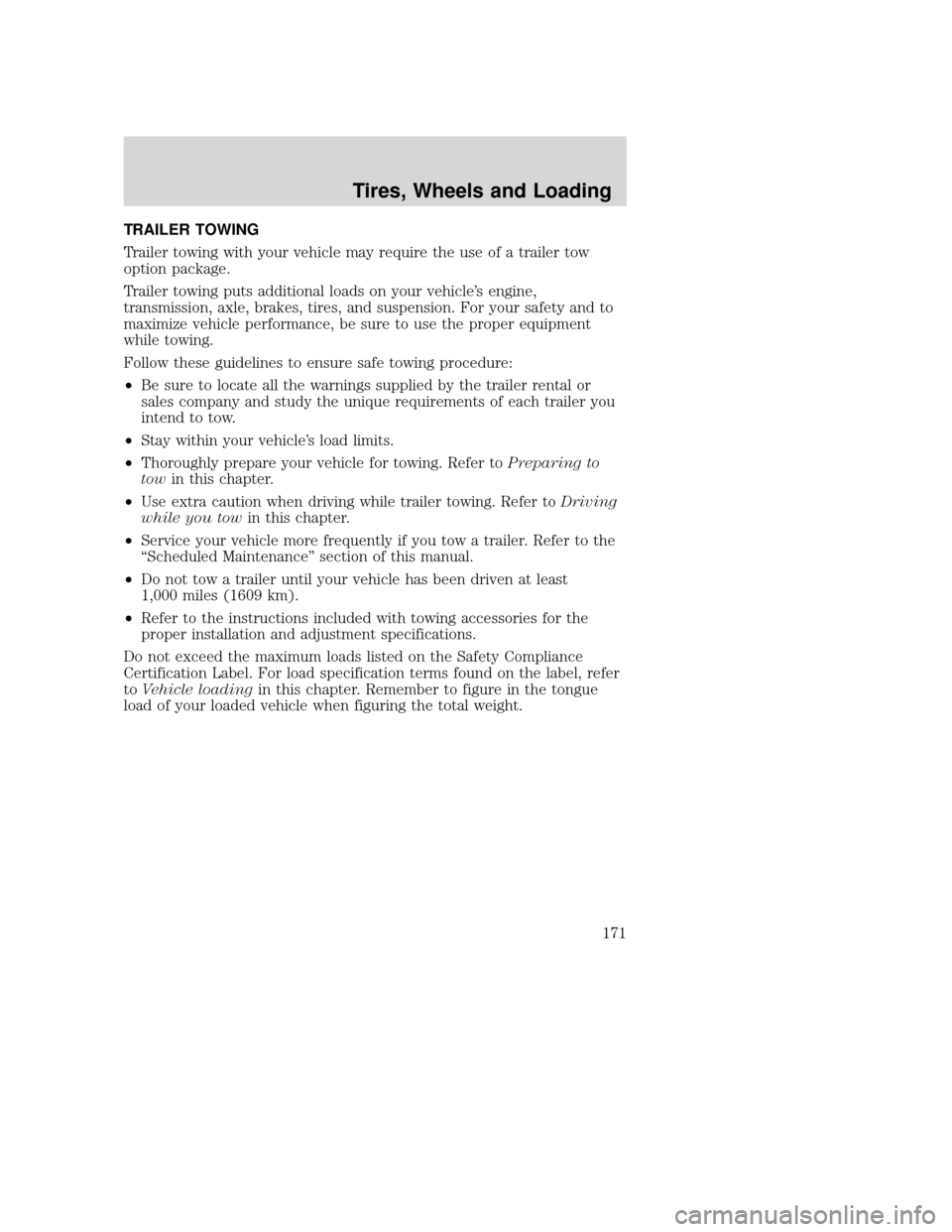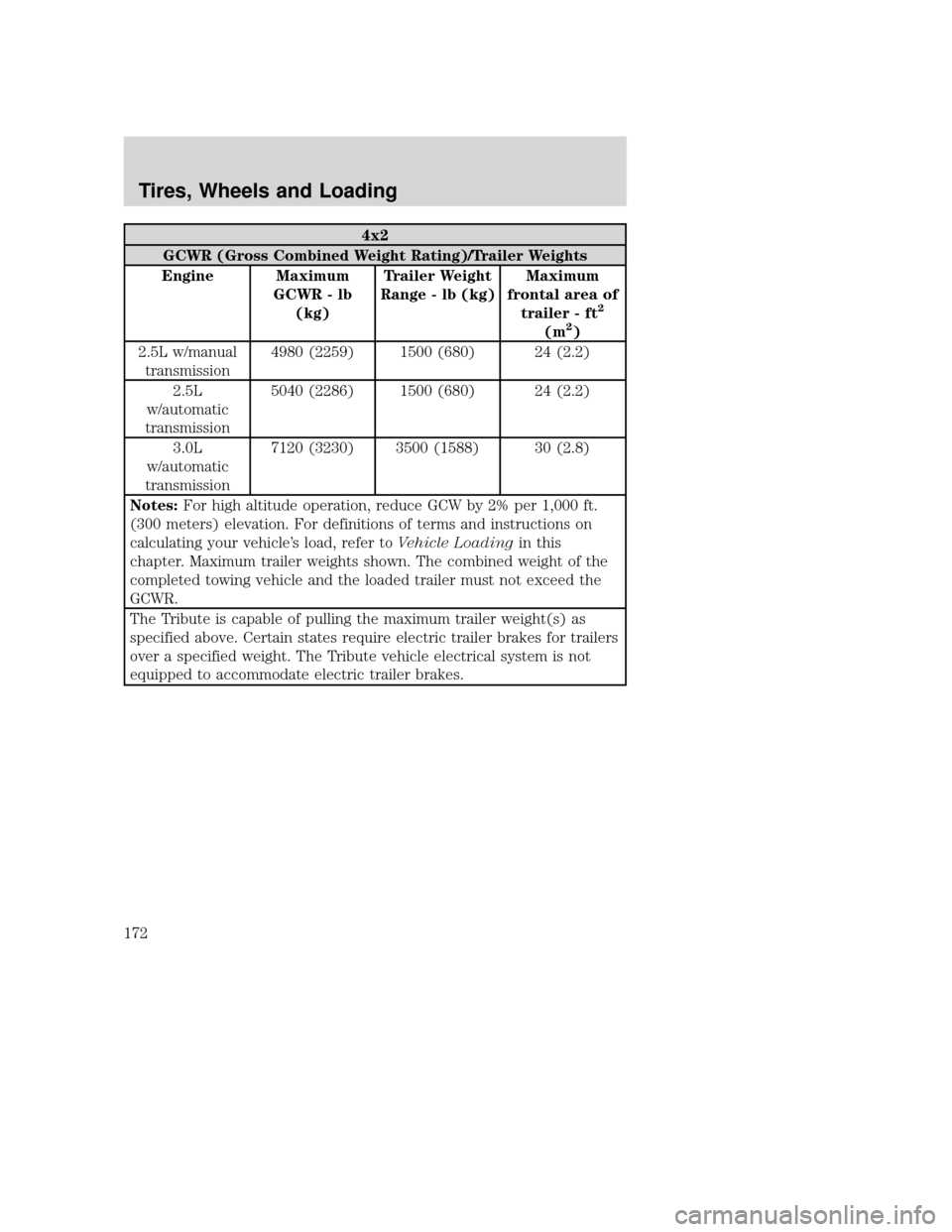brakes MAZDA MODEL TRIBUTE 2009 Owners Manual (in English)
[x] Cancel search | Manufacturer: MAZDA, Model Year: 2009, Model line: MODEL TRIBUTE, Model: MAZDA MODEL TRIBUTE 2009Pages: 304, PDF Size: 1.97 MB
Page 2 of 304

Seating and Safety Restraints82
Seating 82
Safety restraints 93
Airbags 108
Child restraints 124
Tires, Wheels and Loading141
Tire information 143
Tire inflation 145
Tire Pressure Monitoring System (TPMS) 159
Vehicle loading 164
Trailer towing 171
Recreational towing 176
Driving178
Starting 178
Brakes 184
Electronic stability control 187
Transmission operation 193
Roadside Emergencies207
Hazard flasher switch 207
Fuel pump shut-off switch 207
Fuses and relays 208
Changing tires 215
Wheel lug nut torque 226
Overheating 227
Jump starting 228
Wrecker towing 234
Customer Assistance236
Reporting safety defects (U.S. only) 246
Reporting safety defects (Canada only) 246
Cleaning247
Table of Contents
2
2009 Tribute(j14)
Owners Guide, 1st Printing
USA (fus)
Page 57 of 304

CRUISE CONTROL/SPEED CONTROL (IF EQUIPPED)
With cruise control/speed control set, you can maintain a set speed
without keeping your foot on the accelerator pedal.
WARNING:Using cruise control in the following conditions
could cause you to lose control of the vehicle:
• Heavy or unsteady traffic
• Slippery or winding roads
• Similar restrictions that require inconsistent speed
Don’t use cruise control in these situations.
Setting speed control
The controls for using your speed
control are located on the steering
wheel for your convenience. 1. Press the ON control and release it.
2. Accelerate to the desired speed.
3. Press the SET + control and release it.
4. Take your foot off the accelerator pedal.
5. The indicator light
on the
instrument cluster will turn on.
Note:
• Vehicle speed may vary momentarily when driving up and down a
steep hill.
• If the vehicle speed increases above the set speed on a downhill, you
may want to apply the brakes to reduce the speed.
2009 Tribute (j14)
Owners Guide, 1st Printing
USA (fus)
Driver Controls
57
Page 99 of 304

•This seat belt system has a retractor assembly that is designed to pay
out webbing in a controlled manner. This feature is designed to help
reduce the belt force acting on the occupant’s chest.
All seat belts in the vehicle are combination lap and shoulder belts. The
passenger seat belts have two types of locking modes described below:
Vehicle sensitive mode
This is the normal retractor mode, which allows free shoulder belt length
adjustment to your movements and locking in response to vehicle
movement. For example, if the driver brakes suddenly or turns a corner
sharply, or the vehicle receives an impact of approximately 5 mph
(8 km/h) or more, the combination seat belts will lock to help reduce
forward movement of the driver and passengers.
Automatic locking mode for use with child safety seats
When to use the automatic locking mode
In this mode, the shoulder belt is automatically pre-locked. The belt will
still retract to remove any slack in the shoulder belt. The automatic
locking mode is not available on the driver seat belt.
This mode should be used any timea child safety seat, except a
booster, is installed in passenger front or rear seating positions. Children
12 years old and under should be properly restrained in a rear seating
position whenever possible. Refer to Safety restraints for childrenor
Safety seats for children later in this chapter.
How to use the automatic locking mode for use with child safety
seats
• Buckle the combination lap and
shoulder belt.
2009 Tribute (j14)
Owners Guide, 1st Printing
USA (fus)
Seating and Safety Restraints
99
Page 168 of 304

WARNING:Exceeding the Safety Compliance Certification Label
vehicle weight rating limits could result in substandard vehicle
handling or performance, engine, transmission and/or structural
damage, serious damage to the vehicle, loss of control and personal
injury.
GCW (Gross Combined Weight) – is the weight of the loaded vehicle
(GVW) plus the weight of the fully loaded trailer.
GCWR (Gross Combined Weight Rating) – is the maximum allowable
weight of the vehicle and the loaded trailer – including all cargo and
passengers – that the vehicle can handle without risking damage.
(Important: The towing vehicle’s braking system is rated for operation at
GVWR, not at GCWR.) Separate functional brakes should be used for
safe control of towed vehicles and for trailers where the GCW of the
towing vehicle plus the trailer exceed the GVWR of the towing vehicle.
The GCW must never exceed the GCWR.
Maximum Loaded Trailer Weight – is the highest possible weight of a
fully loaded trailer the vehicle can tow. It assumes a vehicle with only
mandatory options, no cargo (internal or external), a tongue load of
10–15% (conventional trailer) or king pin weight of 15–25% (fifth wheel
trailer), and driver only (150 lb. [68 kg]). Consult your authorized
dealer (or the RV and Trailer Towing Guide provided by your
authorized dealer) for more detailed information.
Tongue Load or Fifth Wheel King Pin Weight – refers to the amount
of the weight that a trailer pushes down on a trailer hitch.
Examples: For a 5,000 lb. (2,268 kg) conventional trailer, multiply 5,000
by 0.10 and 0.15 to obtain a proper tongue load range of 500 to 750 lb.
(227 to 340 kg). For an 11,500 lb. (5,216 kg) fifth wheel trailer, multiply
by 0.15 and 0.25 to obtain a proper king pin load range of 1,725 to
2,875 lb. (782 to 1,304 kg)
WARNING: Do not exceed the GVWR or the GAWR specified on
the Safety Compliance Certification Label.
2009 Tribute (j14)
Owners Guide, 1st Printing
USA (fus)
Tires, Wheels and Loading
168
Page 171 of 304

TRAILER TOWING
Trailer towing with your vehicle may require the use of a trailer tow
option package.
Trailer towing puts additional loads on your vehicle’s engine,
transmission, axle, brakes, tires, and suspension. For your safety and to
maximize vehicle performance, be sure to use the proper equipment
while towing.
Follow these guidelines to ensure safe towing procedure:
•Be sure to locate all the warnings supplied by the trailer rental or
sales company and study the unique requirements of each trailer you
intend to tow.
• Stay within your vehicle’s load limits.
• Thoroughly prepare your vehicle for towing. Refer to Preparing to
tow in this chapter.
• Use extra caution when driving while trailer towing. Refer to Driving
while you tow in this chapter.
• Service your vehicle more frequently if you tow a trailer. Refer to the
“Scheduled Maintenance” section of this manual.
• Do not tow a trailer until your vehicle has been driven at least
1,000 miles (1609 km).
• Refer to the instructions included with towing accessories for the
proper installation and adjustment specifications.
Do not exceed the maximum loads listed on the Safety Compliance
Certification Label. For load specification terms found on the label, refer
to Vehicle loading in this chapter. Remember to figure in the tongue
load of your loaded vehicle when figuring the total weight.
2009 Tribute (j14)
Owners Guide, 1st Printing
USA (fus)
Tires, Wheels and Loading
171
Page 172 of 304

4x2
GCWR (Gross Combined Weight Rating)/Trailer Weights
Engine Maximum GCWR - lb(kg) Trailer Weight
Range - lb (kg) Maximum
frontal area of trailer - ft
2
(m2)
2.5L w/manual transmission 4980 (2259) 1500 (680) 24 (2.2)
2.5L
w/automatic
transmission 5040 (2286) 1500 (680) 24 (2.2)
3.0L
w/automatic
transmission 7120 (3230) 3500 (1588) 30 (2.8)
Notes: For high altitude operation, reduce GCW by 2% per 1,000 ft.
(300 meters) elevation. For definitions of terms and instructions on
calculating your vehicle’s load, refer to Vehicle Loadingin this
chapter. Maximum trailer weights shown. The combined weight of the
completed towing vehicle and the loaded trailer must not exceed the
GCWR.
The Tribute is capable of pulling the maximum trailer weight(s) as
specified above. Certain states require electric trailer brakes for trailers
over a specified weight. The Tribute vehicle electrical system is not
equipped to accommodate electric trailer brakes.
2009 Tribute (j14)
Owners Guide, 1st Printing
USA (fus)
Tires, Wheels and Loading
172
Page 173 of 304

4x4
GCWR (Gross Combined Weight Rating)/Trailer Weights
Engine Maximum GCWR - lb(kg) Trailer Weight
Range - lb (kg) Maximum
frontal area of trailer - ft
2
(m2)
2.5L
w/automatic
transmission 5180 (2350) 1500 (680) 24 (2.2)
3.0L
w/automatic
transmission 7260 (3293) 3500 (1588) 30 (2.8)
Notes: For high altitude operation, reduce GCW by 2% per 1,000 ft.
(300 meters) elevation. For definitions of terms and instructions on
calculating your vehicle’s load, refer to Vehicle Loadingin this
chapter. Maximum trailer weights shown. The combined weight of the
completed towing vehicle and the loaded trailer must not exceed the
GCWR.
The Tribute is capable of pulling the maximum trailer weight(s) as
specified above. Certain states require electric trailer brakes for trailers
over a specified weight. The Tribute vehicle electrical system is not
equipped to accommodate electric trailer brakes.
WARNING: Do not exceed the GVWR or the GAWR specified on
the certification label.
Towing trailers beyond the maximum recommended gross trailer weight
exceeds the limit of the vehicle and could result in:
• engine damage
• transmission damage
• structural damage
• loss of control
• personal injury
Preparing to tow
Use the proper equipment for towing a trailer and make sure it is
properly attached to your vehicle. See your authorized Mazda dealer.
2009 Tribute (j14)
Owners Guide, 1st Printing
USA (fus)
Tires, Wheels and Loading
173
Page 174 of 304

Hitches
Do not use hitches that clamp onto the vehicle bumper. Use a load
carrying hitch. You must distribute the load in your trailer so that
10–15% of the total weight of the trailer is on the tongue.
Safety chains
Always connect the trailer’s safety chains to the frame or hook retainers
of the vehicle hitch. To connect the trailer’s safety chains, cross the
chains under the trailer tongue and allow slack for turning corners.
If you use a rental trailer, follow the instructions that the rental agency
gives to you.
Do not attach safety chains to the bumper.
Trailer brakes
Electric, manual, automatic or surge-type brakes, if compatible with the
vehicle, are safe if installed properly and adjusted to the manufacturer’s
specifications. The trailer brakes must meet local and Federal
regulations.
WARNING:Do not connect a trailer’s hydraulic brake system
directly to your vehicle’s brake system. Your vehicle may not
have enough braking power and your chances of having a collision
greatly increase.
The braking system of the tow vehicle is rated for operation at the
GVWR not GCWR.
Trailer lamps
Trailer lamps are required on most towed vehicles. Make sure all running
lights, brake lights, turn signals and hazard lights are working. Do not
connect trailer lamps directly to your vehicle’s tail lamps. This can cause
damage to your vehicle’s electrical system. See your authorized Mazda
dealer or trailer rental agency for proper instructions and equipment for
hooking up trailer lamps.
Driving while you tow
When towing a trailer:
• To ensure proper “break-in” of powertrain components, do not trailer
tow during the first 1,000 miles (1,600 km) of a new vehicle.
• To ensure proper “break-in” of powertrain components during the first
500 miles (800 km) of trailer towing, drive no faster than 70 mph
(113 km/h) with no full throttle starts.
2009 Tribute (j14)
Owners Guide, 1st Printing
USA (fus)
Tires, Wheels and Loading
174
Page 175 of 304

•Turn off the speed control. The speed control may shut off
automatically when you are towing on long, steep grades.
• Consult your local motor vehicle speed regulations for towing a trailer.
• To eliminate excessive shifting, use a lower gear. This will also assist
in transmission cooling. For additional information, refer to Automatic
transmission operation in theDriving chapter.
• Anticipate stops and brake gradually.
• Do not exceed the GCWR rating or transmission damage may occur.
Servicing after towing
If you tow a trailer for long distances, your vehicle will require more
frequent service intervals. Refer to your scheduled maintenance
information for more information.
Trailer towing tips
• Practice turning, stopping and backing up before starting on a trip to
get the feel of the vehicle trailer combination. When turning, make
wider turns so the trailer wheels will clear curbs and other obstacles.
• If you are driving down a long or steep hill, shift to a lower gear. Do
not apply the brakes continuously, as they may overheat and become
less effective.
• Allow more distance for stopping with a trailer attached.
• The trailer tongue weight should be 10–15% of the loaded trailer
weight.
• After you have traveled 50 miles (80 km), thoroughly check your
hitch, electrical connections and trailer wheel lug nuts.
• To aid in engine/transmission cooling and A/C efficiency during hot
weather while stopped in traffic, place the gearshift lever in P (Park)
(automatic transmission) or N (Neutral) (manual transmissions).
• Vehicles with trailers should not be parked on a grade. If you must
park on a grade, place wheel chocks under the trailer’s wheels.
Launching or retrieving a boat
When backing down a ramp during boat launching or retrieval,
• Do not allow the static water level to rise above the bottom edge of
the rear bumper.
• Do not allow waves to break higher than 6 inches (15 cm) above the
bottom edge of the rear bumper.
2009 Tribute (j14)
Owners Guide, 1st Printing
USA (fus)
Tires, Wheels and Loading
175
Page 184 of 304

How to use the engine block heater
Ensure the receptacle terminals are clean and dry prior to use. To clean
them, use a dry cloth.
Depending on the type of factory installed equipment, your engine block
heater system may consume anywhere between 400 watts or 1000 watts
of energy per hour. Your factory installed block heater system does not
have a thermostat; however, maximum temperature is attained after
approximately three hours of operation. Block heater operation longer
than three hours will not improve system performance and will
unnecessarily use additional electricity.
Make sure system is unplugged and properly stowed before driving the
vehicle. While not in use, make sure the protective cover seals the
prongs of the engine block heater cord plug.
BRAKES
Occasional brake noise is normal. If a metal-to-metal, continuous grinding
or continuous squeal sound is present, the brake linings may be worn-out
and should be inspected by an authorized dealer. If the vehicle has
continuous vibration or shudder in the steering wheel while braking, the
vehicle should be inspected by an authorized dealer.
Refer toBrake system warning
light in the Instrument Cluster
chapter for information on the brake
system warning light.
Four-wheel anti-lock brake system (ABS)
Since your vehicle is equipped with an Anti-lock Braking System (ABS),
a noise from the hydraulic pump motor and pulsation in the pedal may
be observed during ABS braking events. Pedal pulsation coupled with
noise while braking under panic conditions or on loose gravel, bumps,
wet or snowy roads is normal and indicates proper functioning of the
vehicle’s anti-lock brake system.
NOTE: The ABS performs a self-check after you start the engine and
begin to drive away.
A brief mechanical noise may be heard during this test. This is normal. If
a malfunction is found, the ABS warning light will come on. If the vehicle
has continuous vibration or shudder in the steering wheel while braking,
the vehicle should be inspected by an authorized dealer.
P!
BRAKE
2009 Tribute (j14)
Owners Guide, 1st Printing
USA (fus)
Driving
184